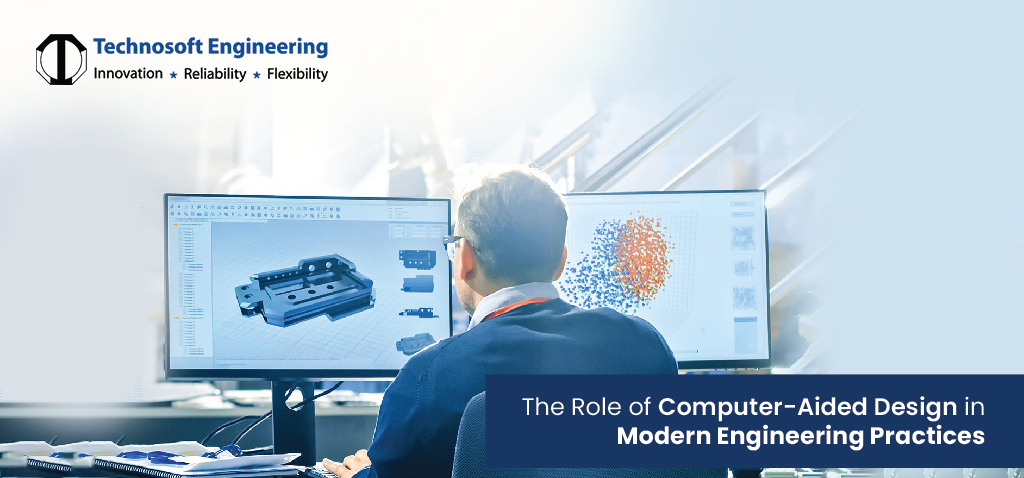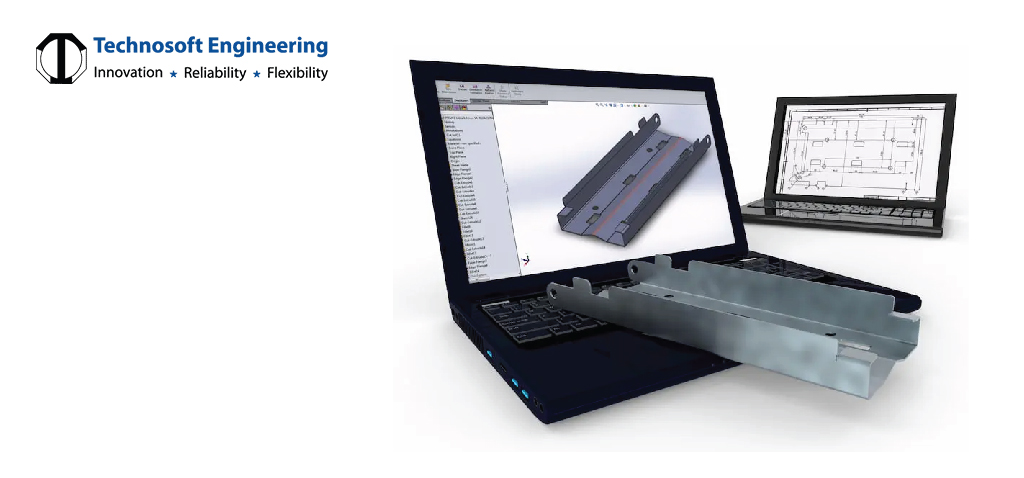
Modern engineering practices are incomplete without the input of computer-aided design (CAD). This technology has transformed the approach of engineers and designers towards product and structure development. With the help of CAD, our expert engineers can develop more detailed and efficient designs for you that will lead to superior outcomes and innovation in many sectors.
With CAD software, our engineers can visualize complex geometries, optimize a design and simulate real world situations. The application of this digital technique has made engineering simpler while at the same time reducing costs and fostering more collaboration between different teams.
Key Takeaways
- Design accuracy is improved by CAD thus promoting efficiency by increasing productivity level hence cutting down on errors resulting from guesswork.
- Cloud-based CAD platforms are enhancing accessibility and collaboration, making it easier for engineers to work together remotely
- CAD when combined with Computer Aided Software Engineering and CAM systems optimizes the entire engineering workflow
- AI, cloud computing and AR/VR are some of emerging technologies that are influencing future outlook for CAD
- Conceptualization to manufacturing: CAD tools play a very important role at different stages in the process of developing products into marketable goods.
What is CAD?
Computer-aided design or CAD refers to applying computer aided technology in design processes as well as design documentation. As opposed to manual drafting, automated procedures are drawn using computer assisted software like AutoCAD. As a result, if you have ever worked within sectors such as architecture, engineering or construction there is a likelihood that you have used 2D or 3D programs for drafting.
The creation of detailed drawings showing physical components takes place through use of Computer Aided Design (CAD) systems. Computer Aided Software Engineering can turn them around any axis including inside view to look inside parts. This level of detail is essential during the designing stage since it could help detect potential troubles ahead thereby saving costs associated with mistakes later done hereafter.
It may also be possible for this software package to generate animations demonstrating how a specific mechanism may work hence making it easier for one to grasp the functionality and performance of a design before it is made. This feature is another reason why Computer Aided Design is better than traditional drafting methods.

How CAD is Changing the Face of Engineering
CAD has completely altered the face of engineering in several ways:
-
Precision and accuracy:
CAD systems provide highly accurate dimensions and measurements, ensuring that designs are precise. By doing this, errors are reduced which in turn saves time and resources as well.
-
Collaboration:
On such projects, CAD software allows for many users at once. Where teams are dispersed among multiple locations, accomplishing large projects can be accelerated through real time updates and shared access that improves communication between team members.
-
Fast Prototyping and Iterations:
Through CAD engineers can quickly prototype or rework designs. The development cycle accelerates when designs can be tested or modified in a virtual world leading to more creative results.
-
Cost efficiency:
Besides reducing the requirement for physical prototypes, CAD also lowers costs by minimizing mistakes. Furthermore, material use optimization also helps save on costs.
-
Complete documentation:
The suite of documentation generated includes bills of material (BOM), assembly instructions and other specifications like part lists from CAD tools automatically. Such documents help maintain consistency during manufacturing to ensure quality end product.

How do CAD, CAE and CAM work together?
Although they play different roles within the overall workflow their functions could be considered as complementary because they all form vital sections in the continuum of engineering process.
-
CAD (Computer-Aided Design):
This refers to software programs used to create models or drawings with high levels of detail about products.
-
CAE:
It is the use of computer software to simulate and analyze the performance of Computer Aided Software Engineering models. CAE tools can predict product behavior under different conditions thereby allowing engineers to optimize their designs. This involves stress analysis, thermal analysis as well as fluid dynamics.
-
CAM (Computer-Aided Manufacturing):
It uses CAD models in manufacturing equipment. CAM software ensures products are manufactured according to design specifications with high efficiency and consistency.
Merging these three systems results in a smooth running process because each stage of product development is linked with another. In an instance, CAE may be used to evaluate a CAD model and fix any potential issues while CAM may take its final design directly for production purposes. This approach increases productivity in projects, reduces mistakes and guarantees that the last item complies with all design specifications.
The Future of CAD
The future of CAD will be influenced by several emerging technologies and trends that promise to change engineering practices even more:
-
Artificial Intelligence (AI) and Machine Learning:
AI is now being integrated into CAD systems to automate routine tasks, enhance designs, and provide predictive insights. At beginning stages AI can better diagnose or suggest improvements on parts than humans.
-
Cloud-Based CAD:
As cloud computing continues advancing it makes CAD tools affordable and more collaborative. Engineers can work from anywhere on projects, share updates in real time, or carry out complex simulations and analyzes using the computational capabilities found on cloud platforms.
-
Augmented Reality (AR) and Virtual Reality (VR):
) These enhanced modes have made it possible for engineers to interact more comprehensively with their designs. Immersive technologies like AR/VR enable virtual prototyping where designers could experience the look, feel etc., without actually making a physical prototype first hence drastically reducing development time frames at reduced costs boosting functionality in the design process.
-
Generative Design:
Generative design refers to a method AI algorithms employ in exploring various possible solutions within a given design space. Through inputting some constraints and goals on the design, software finds several design alternatives that satisfy some given parameters. This approach may lead to novel solutions that are not usually discovered by conventional design methods.
-
Sustainability and Eco-Friendly Designs:
CAD tools have developed differently with increased importance of sustainability in engineering practices. The use of such tools helps in the analysis of various materials and processes’ environmental impacts during product development for greener designs. The trend is prominent for instance in automotive, aerospace as well as construction where companies prioritize sustainable principles.
Key Takeaways
- AI and machine learning are on a path to automate and streamline the CAD process, thereby providing predictive analytics and novel designs.
- Such online CAD and Computer-aided software engineering programs are enhancing accessibility as well as promoting collaboration among engineers who may be working remotely.
- AR and VR technologies have made it possible for engineers to interact with their designs in new ways that reduce development time and expenses.
- Generative design allows for more innovative designs by exploring many alternative possibilities.
- CAD tools are evolving themselves to support eco-friendly and sustainable design practices making sustainability an increasingly important focus.
The Advantages of CAD in Engineering
The team of expert engineers at Technosoft has experienced numerous advantages associated using CAD for computer aided software engineering that has greatly affect the efficiency, quality, and innovation our engineering projects:
-
Increased Productivity:
The use of CAD software simplifies the designing process thus allowing the engineer to work faster. This increased productivity means that projects can be completed faster, and more projects can be handled within the same timeframe.
-
Enhanced Precision and Accuracy:
This precision is provided by CAD applications during complex drawings that would not have been achieved manually. This accuracy ensures proper fitting of all components hence reducing chances of mistakes or reworks.
-
Improved Quality:
Engineers are able to optimize their designs for performance, durability, manufacturability etc using detailed analysis capabilities coupled with simulation abilities present in most CAD tools. As a result, high-quality products will be produced which will perform better for long periods.
-
Cost Savings:
By eliminating physical prototypes as well as minimizing mistakes, there is a reduction in project costs generally. Furthermore, material wastage is optimized through this software; therefore there are huge production savings.
-
Better Visualization and Communication:
3D images can be rendered from any given perspective showing the final product’s particulars clearly. This makes it easier for both personnel involved in production processes as well as customers or clients to understand the plan being discussed thus leading to better decisions by them.
-
Documentation and Record Keeping:
Apart from creating complex structures, CAD systems prepare a comprehensive documentation of manufacturing specifications and descriptions. These are vital to production, ensuring consistency and quality throughout the process.
The Role of CAD in Engineering
CAD plays a significant role through various engineering stages from idea stage to final production and maintenance:
-
Conceptualization:
CAD helps engineers during brainstorming sessions in the early stages of a project by providing them with a way to visualize ideas as well as different design alternatives. Additionally, rapid sketches or models can be created for use in brainstorming and innovation.
-
Design Development:
Inclusive of intricate geometries and assemblies, CAD tools facilitate more fine-grained elaborations on designs. This allows engineers to test new configurations, make simulations, and finally refine the design.
-
Analysis and Testing:
The CAE capabilities embedded within CAD programs allow for engineers’ simulations with models that include stress analysis materials along with thermal properties as well as fluid behaviors that predict real world performance.
-
Manufacturing:
Measures generated by CAD systems help control manufacturing equipment so that parts are made accurately and efficiently. CAM software utilizes these instructions to automate the production process minimizing the need for human intervention.
-
Maintenance and Upgrades:
They provide guidance for troubleshooting problems or making adjustments through detailed documentation & 3D models hence enabling product maintenance over time.
Key Takeaways
- CAD technology has changed modern engineering practices by increasing design precision, efficiency, and collaboration radically.
- Integrating CAD with CAE and CAM systems simplifies the process of engineering from design to production, thus optimizing the entire engineering process.
- CAD is transforming how products are designed and manufactured by merging AI, cloud computing, and AR/VR potentials.
- Some of these benefits include increased productivity in engineering, lowered costs, enhanced designing quality as well as visualization and communication improvements.
- The role played by CAD tools in product development is invaluable starting from creating ideas to manufacturing and maintenance procedures.
Conclusion
Computer Aided Design (CAD) has become a vital tool in the contemporary world’s engineering sectors resulting in innovation, efficiency and quality. By marrying CAD with CAE and CAM systems, engineers can develop precise designs that have been optimized for their use while streamlining all other operations in the entire process of engineering.
As technology continues to evolve, CAD will undoubtedly play an even more significant role in shaping the future of computer aided software engineering. Making effective use of CAD can lead to superior products produced on time within a competitive market environment. To stay ahead of innovation excellence in the industry, Technosoft Engineering embraces these latest developments that are being experienced through the world of engineering.

